| Diese Seite auf Deutsch! |
Freshwater SnailsPart 2: Lung-Breathing Snails |
|
 |
||||||||||||||||||||||||||||||||
| Number of species in Mollusca, displayed by classes, including percentage. Sources: WoRMS: MolluscaBase eds. (2025): Mollusca LINNAEUS, 1758. | |||||||||||||||||||||||||||||||||
Snails and mussels are the only mollusc classes that are not confined to the sea but also can be found in freshwater habitats, namely in rivers and streams, lakes, ponds, and springs. The environmental conditions in these inland waters habitats differ fundamentally from the relatively stable marine habitat. Freshwater habitats are characterised by significant fluctuations in temperature, water levels, currents, and chemical composition. This places special demands on the organisms that live there.
In addition, there is a high degree of ecological fragmentation: many freshwater habitats are isolated from one another, which encourages the genetic separation of populations and, in the long term, the emergence of new species (adaptive radiation). These processes have led to a high diversity of snails and mussels in freshwater, just as they have on land.
Compared to other mollusc classes that are exclusively marine, snails (Gastropoda) form by far the most species-rich group, with around 73,000 known extant species (as of 2024), of which approximately one third are non-marine. Among the approximately 20,000 known bivalve species (Bivalvia), a significant number also live in freshwater. Other mollusc classes, such as chitons, tusk shells, or cephalopods, are exclusively marine.
| Systematics of Pulmonata: (Simplified!) | |
|
Heterobranchia Euthyneura Source: WoRMS: MolluscaBase eds. (2025): Heterobranchia BURMEISTER, 1837. |
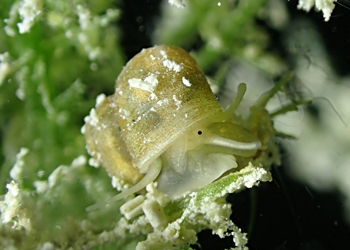 Valve Snail (Valvata piscinalis, Valvatidae, Heterobranchia). Picture: Pierre Corbrion (iNaturalist): Beaumont-sur-Oise, France. |
![]() Stijn Ghequiere:
Apple Snails.
Stijn Ghequiere:
Apple Snails.
However, the traditional grouping "pulmonates" could not be upheld from a systematic standpoint. Today, several groups of lung-bearing snails are recognised, which did not evolve from a common ancestor but instead developed their lungs independently. Modern classification systems reflect this situation: a picture still being refined through ongoing research.
The following overview focuses in particular on the group Hygrophila
("aquatic pulmonates"), that are those lung-bearing snails which, despite
lacking both gills and an operculum, have successfully colonised freshwater
environments in large numbers and with remarkable diversity.
![]() Marine Gastropods:
Systematics and Diversity:
Heterobranchia.
Marine Gastropods:
Systematics and Diversity:
Heterobranchia.
![]() How Did Snails Come to Live on
Land?
How Did Snails Come to Live on
Land?
| Systematics of Hygrophila: (Simplified!) |
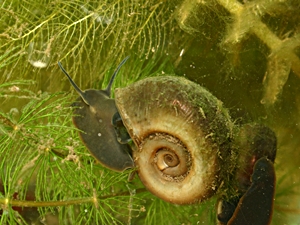 Ramshorn snail (Planorbarius corneus, Planorbidae). Picture: © Alexander Mrkvicka, Vienna. |
||
|
Hygrophila Source: WoRMS: MolluscaBase eds. (2025): Hygrophila A. FÉRUSSAC, 1822. |
However, cladistic studies by BARKER (2001) and DAYRAT et al. (2001) did not support the monophyly (see Cladistic Systematics) of Basommatophora, but instead confirmed that of Hygrophila, as represented in a simplified classification system shown alongside, based on WoRMS (2025).
![]() WoRMS: MolluscaBase eds. (2025):
Hygrophila A. FÉRUSSAC, 1822.
WoRMS: MolluscaBase eds. (2025):
Hygrophila A. FÉRUSSAC, 1822.![]() WoRMS: MolluscaBase eds. (2025):
Basommatophora KEFERSTEIN, 1865:
Quellen.
WoRMS: MolluscaBase eds. (2025):
Basommatophora KEFERSTEIN, 1865:
Quellen.
In the superfamily Lymnaeoidea, four families of freshwater pulmonate snails are currently grouped together, and will be presented in more detail on this page:
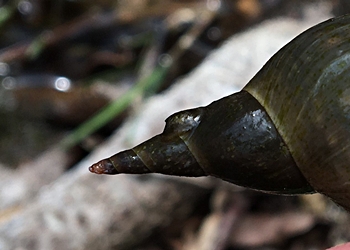 Lake limpet (Acroloxus lacustris) on a pond snail. Picture: Sariai (iNaturalist): Sariai, Lithuania. |
This distinguishes the lake limpet from several other freshwater limpets – particularly species of Ancylus and Ferrissia in Europe, which belong to the family Planorbidae. These are left-handed, and in the case of the very similar Ferrissia species, the shell apex even points to the right.
The unusual shell shape is closely tied to the snail’s lifestyle: Acroloxus lacustris prefers to live on submerged plants such as Myriophyllum (water milfoil) or Potamogeton (pondweed), clinging tightly to the upper surface of the leaves.
|
|
With a shell length of only 4–7 mm, lake limpets are among the smaller water pulmonates – but they are remarkable for their specialised shape and lifestyle. Reproduction takes place via jelly-like egg masses, which are attached to the underside of plant surfaces. Like other aquatic pulmonates, the lake limpet breathes atmospheric air through a breathing hole (pneumostome), which it brings to the water surface. On the right-hand side of the lung cavity, however, Acroloxidae also possess a secondary gill.
Lake limpets are probably an evolutionarily very old group of snails. However, due to the small size and lack of shell features, their fossil record is unclear. Isolated fossil finds have been attributed to Acroloxidae from the mid-Cretaceous (87 million years ago), but the group is thought to have originated much earlier.
Ecologically, lake limpets play an important role in the use of biofilm on aquatic vegetation: they feed on algae, bacteria and detritus accumulating on plant surfaces, thereby contributing to the health of macrophyte populations. Because of their specific way of life, they are especially sensitive to turbidity, siltation, and the decline of submerged vegetation, which makes them a useful indicator of the condition of plant-rich still waters in some regions.
![]() BENTON,
M.J. (Ed.): The Fossil Record 2. Chapman & Hall, London 1993.
BENTON,
M.J. (Ed.): The Fossil Record 2. Chapman & Hall, London 1993.
![]() Francisco
Welter-Schultes:
Family summary: Acroloxidae.
Francisco
Welter-Schultes:
Family summary: Acroloxidae.
![]() Naturportal Südwest:
Acroloxus lacustris (LINNAEUS, 1758) -
Teichnapfschnecke. (In German).
Naturportal Südwest:
Acroloxus lacustris (LINNAEUS, 1758) -
Teichnapfschnecke. (In German).
![]() Freshwater Limpets:
Lake Limpet
(Acroloxus lacustris).
Freshwater Limpets:
Lake Limpet
(Acroloxus lacustris).
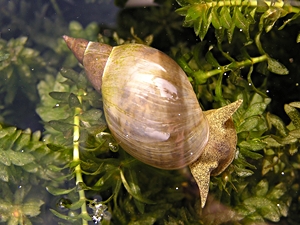 Great pond snail (Lymnaea stagnalis). Picture: Robert Nordsieck. | |
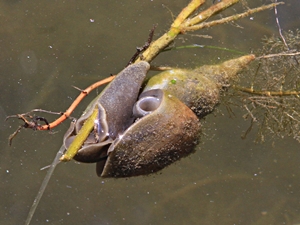 Great pond snail breathiung at the water surface. Picture: Oleg Kosterin (iNaturalist): Shushenskiy, KX, Russia. |
Characteristic of the family is the high-spired, dextrally coiled shell, which in the great pond snail (Lymnaea stagnalis) can reach up to 7 cm (~2.5 in.) in length. Thus it can be significantly larger than the Roman snail (Helix pomatia), the largest terrestrial snail native to Central Europe. Depending on habitat, however, the shell can show considerable intraspecific variability: specimens living in wave-exposed zones of large lakes often have shorter spires and broader apertures, while individuals from reed belts of flowing waters may develop a hooked aperture margin that helps them cling to reed stems.
 Ear pond snail (Radix auricularia). Picture: © Alexander Mrkvicka, Vienna. |
|
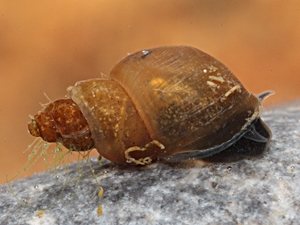 Lesser pond snail or liver fluke snail (Galba truncatula). Picture: © Alexander Mrkvicka, Vienna. |
Pond snails are highly adaptable, both in terms of habitat and diet. Most are grazers, feeding on biofilm composed of algae, bacteria and detritus scraped from plants, stones or other surfaces. Some species may also scavenge carrion or plant debris during times of food scarcity.
Like other aquatic pulmonates, they breathe atmospheric air through a breathing pore (pneumostome), but they can also absorb oxygen through their skin. In oxygen-poor waters, they regularly surface to breathe. Lymnaea stagnalis tolerates pH values from 6.5 to 9 and is thus absent from acidic peat bogs and other lime-poor habitats. However, it can survive temporary drying or freezing of its environment. It also tolerates salinities up to 0.7% (~7 PSU) and is found in the northern Baltic Sea, though with smaller shell sizes (20–30 mm). The oval pond snail (Ampullaceana balthica) is less tolerant of brackish water (up to ~0.3% or 3 PSU) and is thus more restricted to low-salinity coastal areas, such as shallow bays and lagoons along the eastern Baltic coast.
Ampullaceana balthica also is the main indicator fossil for the time period in Baltic Sea geological history 4,000 - 1,500 years ago called the Lymnaea Sea.
Pond snails are somewhat sensitive to warmer water temperatures: from 26 °C upwards, mortality rates rise sharply due to oxygen depletion.
Lymnaeidae have also been used in genetic research: using the common pond snail (then Lymnaea peregra, now Radix labiata), the American geneticist Alfred H. Sturtevant (1891–1970) demonstrated how shell coiling direction is inherited.
Ecologically, pond snails play an ambivalent role. On the one hand, they are an important food source for fish; on the other hand, some species – notably the lesser pond snail or liver fluke snail (Galba truncatula) – act as intermediate hosts for parasitic trematodes such as the liver fluke (Fasciola hepatica), the causative agent of fasciolosis, which can lead to considerable losses in grazing livestock.
Some species within the Lymnaeidae are considered pioneer species in Europe, while others, like the marsh pond snail (Omphiscola glabra) or the common marsh snail (Stagnicola palustris), have more specific ecological requirements and are sensitive to pollution and habitat loss. So, although they are often abundant, pond snails can also provide important insights into the ecological condition of freshwater habitats – both through their presence and absence.
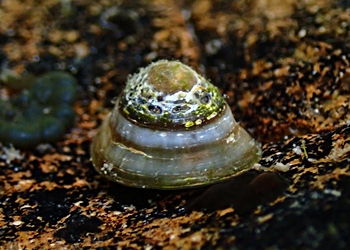 Freshwater limpet (Lanx alta): Northern California, USA. Picture: Justin Garwood (iNaturalist). |
![]() CAMPBELL,
S.C., CLARK, S.A., LYDEARD,
C. (2017): "Phylogenetic analysis of the Lancinae (Gastropoda, Lymnaeidae) ...".
ZooKeys. 663: pp. 107-132. (Link).
CAMPBELL,
S.C., CLARK, S.A., LYDEARD,
C. (2017): "Phylogenetic analysis of the Lancinae (Gastropoda, Lymnaeidae) ...".
ZooKeys. 663: pp. 107-132. (Link).
![]() WoRMS: MolluscaBase eds. (2025):
Lancini HANNIBAL, 1914.
WoRMS: MolluscaBase eds. (2025):
Lancini HANNIBAL, 1914.
![]() WoRMS: MolluscaBase eds. (2025):
Lymnaeidae RAFINESQUE, 1815.
WoRMS: MolluscaBase eds. (2025):
Lymnaeidae RAFINESQUE, 1815.![]() Pond Snails
(Lymnaeidae).
Pond Snails
(Lymnaeidae).![]() Naturportal Südwest:
Schlammschnecken - Lymnaeidae. (In German).
Naturportal Südwest:
Schlammschnecken - Lymnaeidae. (In German).
![]() Nationalpark Donau-Auen:
Spitzschlammschnecke (Lymnaea stagnalis). (In German).
Nationalpark Donau-Auen:
Spitzschlammschnecke (Lymnaea stagnalis). (In German).
|
Physella acuta
– A Neo-Zoon? The acute bladder snail (Physella acuta) was first described in France in 1805. For a long time, it was therefore assu- med to be a native European species. 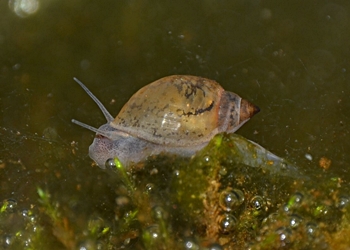 Spitze Blasenschnecke (Physella acuta): Elsass, Frankreich. Bild: Nataël Adam (iNaturalist). However, recent studies have shown that Physella acuta is in fact native to North America, not Europe. Among other evi- dence, fossil records of the species are absent in Europe, whereas in North America it is well documented from fossil deposits. |
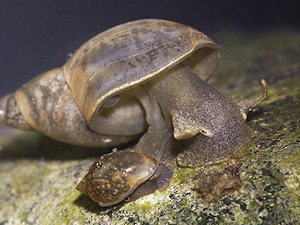 Great pond snail (Lymnea stagnalis) with bladder snail (Physella acuta). Picture: Lars Peters. |
||||
sinistral) in comparison. Pictures not true to scale! Pictures: H. Zell (Source 1, Source 2). |
In addition, they lack the secondary gill often visible in Planorbidae as a lobe-like organ protruding from the mantle cavity.
Bladder snails inhabit a wide variety of freshwater environments worldwide, from clear spring-fed streams to nutrient-rich ponds and urban canals. In Central Europe, Physella acuta and Physella gyrina are the most widespread species. Physella acuta is now considered an introduced species from North America: although it was first described in France in 1805, fossil evidence and recent studies (2016) have shown the species to be native to the United States, where it is common, while such fossils are absent in Europe.
![]() LYDEARD, C., CAMPBELL,
D., GOLZ, M. (2016): "Physa acuta DRAPARNAUD,
1805 Should be Treated as a Native of North America, Not Europe". Malacologia.
59, 2, (Abstract).
LYDEARD, C., CAMPBELL,
D., GOLZ, M. (2016): "Physa acuta DRAPARNAUD,
1805 Should be Treated as a Native of North America, Not Europe". Malacologia.
59, 2, (Abstract).
Bladder snails are highly active gastropods. Under optimal conditions, they can reach crawling speeds of up to 12 metres per hour – making them among the fastest snails known. They are omnivorous, grazing on algae, biofilm and detritus, but also consuming animal matter when available.
![]() How Fast are Snails? A Comparison.
How Fast are Snails? A Comparison.
Like other aquatic pulmonates, Physidae are hermaphrodites. However, unlike pond snails (Lymnaeidae), their reproduction is reciprocal rather than unidirectional. They are capable of self-fertilisation for colonising new habitats, although with less success than some other families. The gelatinous egg masses of bladder snails typically contain several dozen eggs and are attached to plants, stones, or aquarium glass.
Due to their rapid generation time and high reproductive rate, bladder snails are considered pioneer species of newly formed or disturbed habitats. They are tolerant of pollution and low oxygen levels, making them robust bioindicators of eutrophic waters – although usually in a negative sense: mass occurrences often signal nutrient overload or environmental disturbance. At the same time, their high mobility and broad diet make them ecologically important as scavengers and cleaners on the bottoms of freshwater systems.
Bladder snails are popular aquarium inhabitants due to their algae-grazing habits, but under favourable conditions they can multiply rapidly and contribute to increased sedimentation.
![]() Bladder Snails
(Physidae).
Bladder Snails
(Physidae).
![]() Wikipedia:
Physella acuta.
Wikipedia:
Physella acuta.
![]() Naturpostal Südwest:
Blasenschnecken (Physidae). (In German).
Naturpostal Südwest:
Blasenschnecken (Physidae). (In German).
| Systematics of Planorbidae: (Simplified!) | |
|
Familie Planorbidae Source: WoRMS: MolluscaBase eds. (2025): Planorbidae RAFINESQUE, 1815. |
|
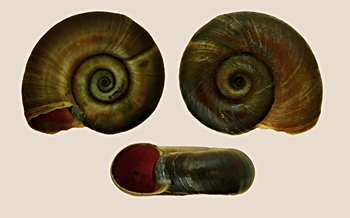 Ramshorn snail (Planorbarius corneus): Left: Apical view, Right: Umbilical view. Picture: H. Zell (Source). |
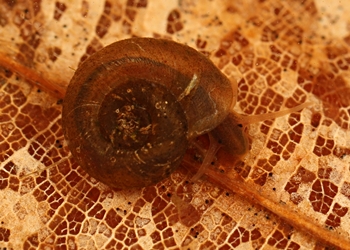 White ramshorn snail (Gyraulus albus): Ypres, Belgium. Picture: Marie Lou Legrand (iNaturalist). |
The family Planorbidae is a diverse and species-rich group of freshwater pulmonate snails. About 40 valid genera and roughly 300 species are currently recognised, though more than 70 genera have been described in total.
While the majority of planorbids are characterised by their typically flat, disc-shaped or tightly coiled shells (the scientific name Planorbis literally means flat circle in Latin), there is also a group within the subfamily Ancylinae that has limpet-shaped shells. These species, however, have been shown—genetically and anatomically—to belong to the Planorbidae as well.
The systematics of the Planorbidae remain partly unresolved. According to current knowledge, the family is divided into several subfamilies, each of which contains one or more tribes, as shown in the simplified classification based on WoRMS (2025, see box on the left).
In Germany, ten genera comprising 21 species of planorbids are currently recorded: Two of these, Ancylus and Ferrissia, are limpet-shaped, each represented by a single species. At least four species were introduced in the mid-20th century: Menetus dilatatus, Ferrissia wautieri, Gyraulus parvus, and Gyraulus chinensis. In many places across Europe, the American ramshorn snail (Planorbella duryi) has also become established, likely spread through the uncontrolled release of aquarium snails.
![]() GLÖER,
P. (2002): Die Tierwelt Deutschlands. Mollusca I: Süßwassergastropoden Nord- und
Mitteleuropas. 2. Ed., ConchBooks, Hackenheim.
GLÖER,
P. (2002): Die Tierwelt Deutschlands. Mollusca I: Süßwassergastropoden Nord- und
Mitteleuropas. 2. Ed., ConchBooks, Hackenheim.
![]() WoRMS: MolluscaBase eds. (2025):
Planorbidae RAFINESQUE, 1815.
WoRMS: MolluscaBase eds. (2025):
Planorbidae RAFINESQUE, 1815.
Belonging to the same tribe as the American ramshorn snail, Planorbella duryi, Biomphalaria glabrata is originally native to South America but is now widespread across many tropical and subtropical regions.
It plays a central role as an intermediate host for the parasitic flatworm Schistosoma mansoni, the causative agent of intestinal schistosomiasis (also known as bilharzia), a tropical disease affecting millions of people worldwide, particularly in Africa and Latin America.
Due to its significance in the parasite’s life cycle and its ease of cultivation in laboratories, Biomphalaria glabrata has become one of the most important model organisms in tropical medicine and immunobiology. Its genome has been fully sequenced to gain deeper insights into immune responses to parasites and to support the development of effective control strategies for schistosomiasis.
Despite its importance for scientific research, Biomphalaria glabrata is considered invasive in many parts of its introduced range. Efforts to combat the disease therefore include not only medical treatment but also targeted control of snail populations in affected freshwater habitats.
![]() Freshwater Snails as Intermediate Hosts of
Schistosoma.
Freshwater Snails as Intermediate Hosts of
Schistosoma.![]() Agência Brasil:
Scientists sequence genome of snail linked to schistosomiasis (2017).
Agência Brasil:
Scientists sequence genome of snail linked to schistosomiasis (2017).![]() Planeta Invertebrados Brasil:
Biomphalaria (In Portuguese).
Planeta Invertebrados Brasil:
Biomphalaria (In Portuguese).
|
Redblooded Snails? One of the most striking physiological features of planorbid snails is their use of haemoglobin as an oxygen carrier. Unlike in vertebrates, this haemoglobin is not contained within blood cells, but is dissolved freely in the blood plasma. 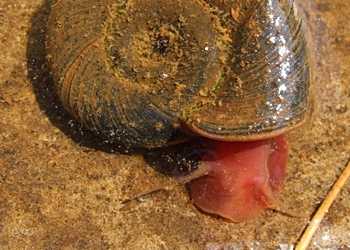
Great ramshorn snail (Planorbarius corneus). Picture: Claus Ableiter (Source). Haemoglobin, which binds oxygen using iron atoms, is more efficient than haemocyanin under conditions of low oxygen concentration. This gives ramshorn snails a distinct advan-tage in hypoxic environments such as stagnant or eutrophic waters. |
Most planorbids are small to very small in size. The best-known native species in Central Europe is the greater ramshorn snail (Planorbarius corneus), which can reach a shell diameter of over 3 cm. Other species, such as the common ramshorn snail (Planorbis planorbis) or the lesser ramshorn snail (Gyraulus albus, see above), are considerably smaller and often occur in large numbers in vegetation-rich freshwater habitats.
Like the bladder snails (Physidae), planorbids possess two long, slender tentacles that cannot be retracted – a shared feature of all Hygrophila. They move with a broad, flat foot that also allows them to cling to aquatic plants and even crawl upside down along the water’s surface film, much like pond snails.
Ramshorn snails breathe air but are also capable of absorbing dissolved oxygen through their skin, as many freshwater snails do. The mantle cavity used for breathing can, in some species – such as the greater ramshorn snail – be used as a swim bladder by regulating the air volume. For instance, the snail can actively expel air to sink to the bottom. Like all other members of the Hygrophila, planorbids are hermaphrodites and lack an operculum.
Unusual among molluscs – which typically rely on the copper-based oxygen carrier haemocyanin – planorbid snails instead use iron-based haemoglobin as their respiratory pigment, most likely as an adaptation to life in oxygen-poor (hypoxic) environments. Unlike in vertebrates, the haemoglobin in planorbid snails is not contained within blood cells but is freely dissolved in the blood plasma. Haemoglobin is more efficient at binding oxygen than haemocyanin, giving many ramshorn snails a physiological advantage in low-oxygen habitats.
![]() LIEB,
B. et al. (2006): Structure and evolution of the extracellular hemoglobins from
Planorbidae. Molecular Biology and Evolution 23(2): 277–287.
LIEB,
B. et al. (2006): Structure and evolution of the extracellular hemoglobins from
Planorbidae. Molecular Biology and Evolution 23(2): 277–287.
Due to the lack of strong skin pigmentation, many planorbids appear pinkish in colour. In some species, such as the American ramshorn snail Planorbella duryi (also known as the Seminole ramshorn snail), this has led to the popularity of albino strains in the aquarium trade. However, improper handling and release of aquarium snails has contributed to the species’ increasing spread in European waters.
![]() American Ramshorn Snail
(Planorbella duryi):
Distribution in Europe.
American Ramshorn Snail
(Planorbella duryi):
Distribution in Europe.
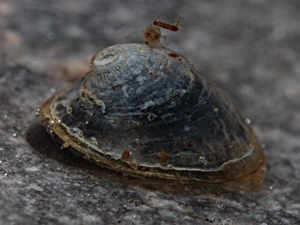 River limpet (Ancylus fluviatilis). Picture: © Alexander Mrkvicka, Vienna. |
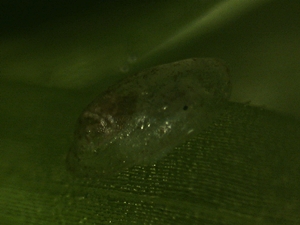 Septate limpet (Ferrissia clessiniana). Picture: © Alexander Mrkvicka, Vienna. |
While most Ferrissia species are considered non-native neozoans introduced from North America (Walther, 2006, e.g. Ferrissia fragilis) or Africa (Kerney, 1999), Ferrissia clessiniana is generally regarded as an autochthonous native species.
River limpets (Ancylus fluviatilis) prefer running water habitats and are typically found on stones in oxygen-rich streams and rivers, from headwaters to larger rivers, and even in karstic springs. In Northern and Western Europe, they also inhabit the wave-exposed shores of lakes, where oxygen levels are elevated. Although usually found on hard substrates, they are occasionally observed on the leaves of aquatic plants.
Septate limpets (Ferrissia clessiniana) can easily be mistaken for
lake limpets (Acroloxus lacustris, see
above). However, unlike Acroloxus, they are sinistral (left-coiled),
and the apex of their shell points to the right. In parts of their range,
Ferrissia clessiniana is threatened by habitat alteration caused by
drainage and urban development. In Switzerland, most habitats have already been
destroyed, and the species is considered highly endangered both there and in
Austria.
In contrast, Ferrissia clessiniana appears to be
expanding its range in England and Wales.
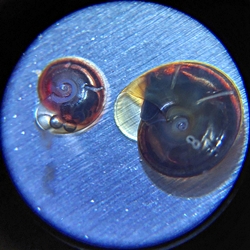
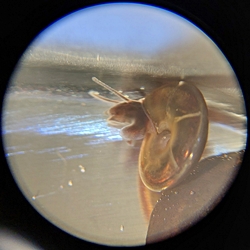 Shining ramshorn snail (Segmentida nitida): Utrecht, Netherlands. Pictures: Jurriën (iNaturalist). |
Planorbid snails play an important ecological role as grazers of biofilms. They feed on algae, bacterial mats, detritus, and other microscopic organisms growing on submerged surfaces and aquatic plants. Ramshorn snails (Planorbarius corneus), in particular, are omnivorous and will also consume carrion, although they rarely feed on living plants.
Some species, such as Planorbarius corneus or Gyraulus albus, are highly tolerant of polluted waters and are therefore considered negative indicator species in ecological assessments.
Other species, such as Anisus vorticulus, Ancylus fluviatilis and Segmentina nitida, are more demanding in their habitat requirements. They are sensitive to environmental degradation and are thus regarded as indicators of near-natural, clear and oxygen-rich waters with stable aquatic vegetation.
![]() Deutsche Malakozoologische Gesellschaft (DMG):
Zierliche Tellerschnecke Anisus vorticulus
(Troschel 1834). (In German).
Deutsche Malakozoologische Gesellschaft (DMG):
Zierliche Tellerschnecke Anisus vorticulus
(Troschel 1834). (In German).![]() Ramshorn Snails (Planorbidae).
Ramshorn Snails (Planorbidae).
![]() Nationalpark Donau-Auen:
Posthornschnecke (Planorbarius corneus). (In German).
Nationalpark Donau-Auen:
Posthornschnecke (Planorbarius corneus). (In German).
Latest Change: 29.06.2025 (Robert Nordsieck).